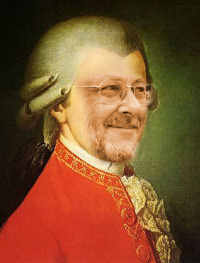A 365-Day Project
"We Are All Mozart"
A project to create
new works and change
the perception of the
music of our time.


 December 1, 2006
December 1, 2006 
We are creatures of malleable regularity. Our life spans are different. We have hearts that beat but also skip and murmur, lungs that expand and contract as needed in a slow and variable pulse, neurons that fire on demand. Yet we seek perfection. The devices we have built since the first era of clockworks have increased in precision and regularity of timing, the buildings grown in precision and regularity of appearance. Numbers have come to matter -- cylinders, monitor pixels, rpm, ISO standards, calories, gigahertz, Dow Jones, letter size, serving size, size 6 -- and what isn't measurable or countable has become suspect.
We remain malleable. We are creatures of direction, not symmetry. The symmetrical face is alien; mirror one side and the face becomes unreal. Purity is failure. The purity of total serialism was such. The Twin Towers were once loathed for their very precision against the jumbled New York skyline. Symmetrical rhythms, like the whole-tone scale, are absent the sense of purpose that characterizes human endeavor. When purity of design pulls too hard on us, we snap back to the biological with its evolution of genes and deprecated fragments of DNA. Deep inside, perfection and symmetry are unreasonable, biologically unreasonable.
Art is the herald of humanity. It flies in the face of both perfection and biology. Sometimes that's its purpose, or we would be satisfield with that beating heart and those pulsing lungs from womb to grave.
Which brings me to the topic: rhythm. Rhythm is commonly understood as a pattern of emphasis in music, durations and stresses and recurrences and repetitions that can be discerned and internalized. Rhythm is easily confounded with its transforms or components -- meters, repetitions, styles of emphasis, shaped patterns, slowed pitches -- and behaves as a chameleon. That behavior not only makes it difficult to talk about, but difficult even to conceptualize once one scratches under the surface.
Consider the natural rhythms. Beyond the breathing and the heartbeat, outside our bodies, there are the rhythms of nature. Days and seasons. Those are easy. Tides and lunar months go at their own pace. Planets move with greater complexity. Two thousand years ago, the earliest complex calculators accommodated some of these irregularities by regularizing them. Yet lifetimes are unpredictable, as are attention spans.
You get the point. Rhythm isn't simple. Okay, yeah, the traditional distinction between rhythm and meter isn't too murky even if it depends on which side of the emphasis you're listening. Meter is a regular grouping of stresses, rhythm is the order of the stresses. Good enough. (Want to get all music-theorized out? Read this.) But as a composer choosing from a postmodern menu, rhythmic choices are enormous. Breathing rhythms or phrases of plainchants. Isorhythms of melody-wrestling stability. Augmented and diminished overlapping baroque rhythms. Classical regularity and its deliberately perverse hemiolas. Broken early romantic and stretched late-romantic rhythms, to the point of obliteration. Polyrhythms of the last century. African polyrhythms and hockets. Minimalism's surfactant regularity and phasing. Faced with these choices, how can a composer take the first step toward forward propulsion (or a Feldman- or Pärt-like absence of it), much less invent & adopt an overarching personal theory of rhythm?
Faced with such a challenge early in my compositional life, I chose to remain rhythmically untethered. There was plenty of naïveté in that choice, but not entirely. My interest in electroacoustics arose along with my interest in 'dot music', and electroacoustics did not have, in my experience, an inherent rhythmic component other than the pulsing that resulted from pitches being slowed to the transition point between tone and pulse. That early observation, coupled with the total serialism that was de rigueur in my formative years and my crude experiments in phasing separate tape loops (already done by Steve Reich, but not yet known to me), effectively erased rhythm from the to-do list. What could be done had been done. With no contribution to make, I stopped consciously exploring.
And freed from the need to advocate for a rhythmic point-of-view, I came to realize that the interest problem with most contemporary music is the blandness of its rhythmic conception. That problem isn't merely with uninteresting music per se, but with the great swath of music, old and new, but especially new. Overly serialized music makes its point effectively, but in the process demeans rhythm and makes it a slave to theory, with its sonic manifestation a jagged acoustic landscape -- not a natural landscape or even a landslide with its normalized array, but rather a kind of strip-mined music. By the same token, cleverly rhythmic music fails in its cleverness; we hear the rhythms, smile and say, "oh, those again" -- even uncommon ones. Think Mission: Impossible or Take Five. Their very irregularity sticks out like Tchaikovsky's 5-beat waltz or the Smothers Brothers' I Like to Waltz. These are the reduction of rhythmic concepts to metrical gimmicks.
Which brings the discussion back to inevitability. The underpinnings of rhythm remain in the biology and its phylogenesis. Rhythm is primal -- which is why composers often fear it, and react by either ignoring it or trying to conquer it. Both will fail. To understand rhythm, one must reach between one's legs and feel the pulse, feel it change, and feel time shift along with it. Rhythm is understood -- literally grasped -- viscerally to know how it lays waste to time. It changes our sense of time and our speech and consequent hearing, even as rhythm and speech are themselves intertwined in the two halves of the brain. Rhythm out changes rhythm in. And so each of the grand rhythmic concepts of music arises from its visceral characteristics, not its numeracy. The numeracy -- scientific or mystic -- is a consequence of the intellectualization of biology.
Yes, one can say that about any aspect of the arts, but it will be forced. With rhythm, it is inevitable. The dissonance of rhythm causes far more pain than the dissonance of harmony, just as the consonance of rhythm causes more passion. In the face of rhythmic consonance, the resolution of the Tristan chord is pale as death.
Tomorrow I'll give examples and talk about some less-explored areas of rhythm.

A sophisticated musical score of natural and artifical rhythms, inevitable stresses, fractured contours, and two-dimensional rhythmic emphases: our woodpile.